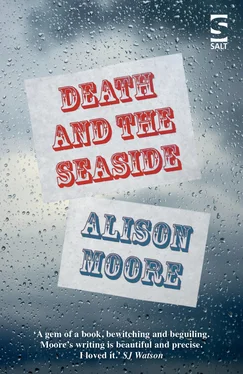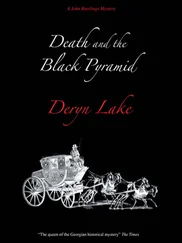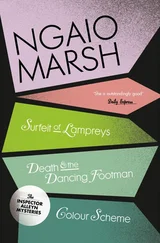All of Bonnie’s unfinished stories have been printed out and kept together in the same place: in the drawer of my grandmother’s old Mission desk. This desk used to stand in the hallway of the house in which I grew up, and in its single, wide drawer my grandmother kept all her personal paperwork. I was told, when I was little: “Sylvia, you must not touch this desk. It is out of bounds.” Despite this caution, or perhaps because of it, I did, quite compulsively, touch the Mission desk. Even when I was really only walking past it, my arm would levitate and, before I knew it, my fingers were touching the legs or the front of the drawer. I could not help it. I was especially forbidden to open the drawer, but it had no lock. The desk is now in my possession anyway. It is in my house, in the ground-floor flat.
All these unfinished stories of Bonnie’s are set by the sea, and one must ask: why this obsession with the sea? She does not live there, although she could. When considering this question, one ought to take into account the fact that in each of Bonnie’s stories — as well as in many of the novels on her bookshelves — the sea is a metaphor for death. Correspondingly, to be at the seaside is to be at the edge of death. The seashore is a threshold. This, in fact, seems to have been the focus of Bonnie’s unfinished dissertation, which she had been sketching out before abandoning her university course. I have had the opportunity of seeing the pages of notes made in preparation for this major piece of work, which was never completed, and I have endeavoured to put them into some sort of order here.
Bonnie’s notes refer to the ancient seashore being “haunted by the possibility of a monster bursting forth”, a monster that might represent an invader, or the Black Death, or there might be actual monsters, “nightmarish creatures born out of black waters” (Corbin, The Lure of the Sea: The Discovery of the Seaside in the Western World 1750–1840 ). The monsters might even have names, like Leviathan or the Kraken, or they might be unnamed, like the inhuman sea creatures of Innsmouth — “They were mostly shiny and slippery, but the ridges of their backs were scaly. Their forms vaguely suggested the anthropoid, while their heads were the heads of fish, with prodigious bulging eyes that never closed” (Lovecraft, The Shadow Over Innsmouth ) — or like the shark in Jaws (for the modern-day seashore remains equally haunted, it seems, by the possibility of a monster bursting forth). The sea, writes Bonnie, is the domain of the Under Toad, a misunderstanding of the word “undertow”, an unseen danger: “lurking offshore, waiting to suck him under and drag him out to sea. The terrible Under Toad… Would it ever surface?” The reek of toad, the Under Toad’s “swampy smell”, is the reek of death (Irving, The World According to Garp ). The monster might even be seen, might indeed burst forth: “ I saw a monster rising from the waves … However: it is possible, perhaps plausible, to conjecture that the sea monster which I ‘saw’ was a hallucination” (Murdoch, The Sea, The Sea ). In Bonnie’s books, the sea itself has waves “like huge mouths snapping at the empty air, waiting for us” (Olmi, Beside the Sea ). The sea is something that devours. The children are “made uneasy by this waveless, unstoppable tide, the sinister, calm way it kept coming on”, and so they should be: “whatever cliffs there may once have been the sea had long ago eroded” (Banville, The Sea ).
The sea represents the dimmer regions of the subconscious, inhabited by dreams and nightmares — “She thought: people slip off the shores of the real world, back into dreams” (Swift, “Learning to Swim”) — and by madness: the ocean, “that unruly dark side of the world which was an abode of monsters stirred up by diabolical powers, emerges as one of the persistent figures of madness” (Corbin, The Lure of the Sea ). To be in “the world under the sea”, “at the bottom of the ocean”, is to be in a “dead” mood, a trance-like state (Hamilton, Hangover Square ). The philosophers Kant and Schopenhauer draw a parallel between dreaming and madness: Kant writes that, “The madman is a waking dreamer”, and Schopenhauer calls dreams a brief madness and madness a long dream (Freud, The Interpretation of Dreams ).
The sea, writes Bonnie, was believed to produce unhealthy emanations at the shore, “bad air”, which might be attributed to the seaweed, the debris, “the excreta from the abyss”, which accumulated on the sand (Corbin, The Lure of the Sea ). And/or it might be explained by the sea being “a freezing great floating graveyard”, so that taking a lilo into the shallows is akin to playing at the edge of an ancient Indian burial ground. The sea looks “like a torrent of mud”, and being on the beach is like “being in a cardboard box”, which suggests a makeshift coffin, ready for burial (Olmi, Beside the Sea ).
The narratives themselves, notes Bonnie, have an untethered quality: “Later that day, the day the Graces came, or the following one, or the one following that, I saw the black car again” (Banville, The Sea ). The narratives shift suddenly and easily from one time frame to another, or from one point of view to another. Or there are commas where one might expect full stops, and a lack of speech marks, giving a sense of fluidity, a lack of boundaries, one “sentence” washing into the next: “Kevin and Stanley were clean, they were getting ready for the night, as they said, yes, they often said I’m getting ready for the night, it’s nice, getting yourself all sorted for the night, they never say I’m getting ready for the day, because daytime doesn’t really warrant it, you’ve got to do it so you do, that’s all, but at night there’s a sort of preparation, like before a journey” (Olmi, Beside the Sea ).
The “irresistible awakening of a collective desire for the shore” that arose around 1750 sounds to me like mass hypnosis. “Cure-takers began rushing toward the sea-shore… Along the desolate shore, the pleasant song of birds gives way to the sea-gull’s harsh cry.” The cure-takers’ sea-bathing “was part of the aesthetics of the sublime: it involved facing the violent water, but without risk, enjoying the pretence that one could be swept under, and being struck by the full force of the waves, but without losing one’s footing”. My first thought, when I read these notes of Bonnie’s, was that there is a risk, one could lose one’s footing and be swept under, and that this activity must involve flirtation with a death wish. But it turns out that the female cure-taker had a supervisor: “The ‘bathers’ would plunge female patients into the water just as the wave broke, taking care to hold their heads down so as to increase the impression of suffocation.” It sounds brutal, but the end result is that the fey young women become invigorated. The sea is bracing, if also dispassionately vicious. There is a note about exorcism, and when I first read it I thought that what was being referred to was the submersion of people so that they would be purified by the sea. In fact, it means sailors immersing relics into the water in order to purify the demonic sea. But it made me think of the bathers, the supervisors pushing the women’s heads under the water, trying to force some change in them. “At the seaside, sheltered by the therapeutic alibi, a new world of sensations was growing out of the mixed pain and pleasure of sudden immersion… The sea-shore offered a stage on which, more than anywhere else, the actual spectacle of the confrontation between air, water, and land contributed to fostering daydreams about merging with the elemental forces and fantasies of being swallowed up” (Corbin, The Lure of the Sea ).
Читать дальше












